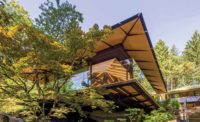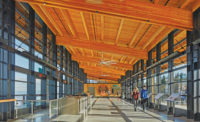I-90/Snowshed to Keechelus Dam Phase 1C project
Hyak, Wash.
Best Project, Highway/Bridge and Award of Merit, Excellence in Safety
Key Players
Owner Washington State Dept. of Transportation
Lead Design Firm Jacobs
Contractor Guy F. Atkinson Construction
Geotechnical Design Geoengineers
Subcontractors KLB Construction; Golder Associates Inc.; HI-TECH Rockfall Construction Inc.
Immediately upon award of a contract from the Washington State Dept. of Transportation to widen a 2.89-mile section of Interstate 90 through Snoqualmie Pass, Guy F. Atkinson Construction submitted a cost reduction incentive proposal to turn the WSDOT-sought snowshed protecting drivers from avalanches into twin 1,200-ft-long avalanche bridges.
Elevating the bridges eliminated the need for a snowshed, raising the three lanes of roadway in each direction above avalanche potential, shoehorning the structures into a mountain pass between an avalanche-prone rock cliff and environmentally sensitive lake. At the same time, the project’s design created a structure able to withstand seismic, landslide and avalanche loads; widened the roadway; and saved WSDOT more than $37 million in long-term maintenance from avalanche removal. Plus, the bridges offered a safer construction method than erecting a new snowshed.
“We were able to come in and save WashDot a bunch of future monies through doing this,” says Philip Larson, Atkinson project manager. “It gave us a great chance to partner with WashDot to train a whole bunch of staff on new construction techniques. When we walked out, we were more of construction professionals than when we started. It was a really fun job.”
The $63-million, nine-year project started with the change to bridges, creating design challenges. Of the three avalanche experts in North America, two were already working with WSDOT, and Atkinson brought in the third to help determine an acceptable risk tolerance to design for. With most avalanche studies done in Switzerland or, for North America, in Colorado, extra work was needed to determine the correct standards for wet Pacific Northwest snow, often up to four times heavier—and slower moving—than elsewhere.
Then came the complexity of working between a mountain cliff prone to movement and Keechelus Lake. Every winter the team planned work for the next season. “You hoped your plan was correct, and then you pushed the weather window,” Larson says. “That was a game we played every fall for eight years, how late to work safely.”
“You hoped your plan was correct, and then you pushed the weather window. That was a game we played every fall for eight years, how late to work safely.”
– Philip Larson, Project Manager, Guy F. Atkinson Construction
The trickiest part of the construction came with nightly rock blasting for five years straight, but only after the eastbound bridge was constructed. Atkinson selected blasting techniques to limit ground accelerations and reduce the potential for damaging the completed bridge. “The rock up there was very incompetent and very weathered with a lot of veins,” he says. “Every time you blasted you never knew what would happen. That constant fear of that rock not acting as it was supposed to every night, that was not standard to me.”
Rock blasting was the only solution to make room for the interstate widening, requiring precautions all around. Atkinson limited how much it blasted at one time, and automated stations across the slope ensured the hillside wasn’t moving, with checks after each blast. “It worked,” Larson says. “No one got hurt, and there were no major slides.”
The alignment of the bridge required clearance of snow accumulation, but not so high that the grades became dangerous during icy conditions. The bridge piers also had to support the bridge but withstand the force of concurrent avalanches and landslides, all while providing room for falling rock to miss the roadway but not moving too close to the lake, which was too deep to support foundations.
The end result taught crews how to overcome challenges, provided drivers with a much-improved roadway and has saved WSDOT time and money in avalanche control, not counting economic and public service savings by not closing the main east-west link across Washington.
“I don’t see a need to perform any avalanche control at the bridge locations unless very specific conditions arise,” says John Stimberis, WSDOT avalanche forecaster and control team supervisor. “Since the avalanche bridges have been in place, we have recorded 22 naturally occurring avalanches that reached the old roadbed. If the snowshed was still in place, I estimate we would have performed nearly 50 avalanche control missions during the period since completion of the avalanche bridges.”








